Calibrating your heater
This post is the third one of a series about controlling by a home automation controller the house heating system described in the first post.
The control systems installed in heaters are fundamentally different from those 20 years ago. Electronics is managing entire device, and it permits to implement sophisticated regulation algorithms.
But due to sophisticated regulation, heater settings are more complex. Improper adjustment of them may have disastrous impact on performance and thermal comfort, increasing then energy consumption.
When building our house, this is a person dedicated to the tuning of the boiler who took control on settings. After 1 hour of installation the full installation was working. Without real testing, those parameters settings shouldn’t match in all cases, these are “standard” settings . After a while I’ve rechecked those parameters.
How to optimize power consumption ?
The rule is simple: the water circulating in the pipes must be the least hot as possible. This applies for heating network as for the domestic hot water system.
Why a lower water temperature reduces consumption ?
- because the energy lost by the heating system is proportional to the difference between the room temperature and the water temperature in pipes
- in the case of a gas boiler, the condensation mechanism is even better than water to be heated is less hot

- in the case of a heat pump, performance’s also following the same trend. Compare, for example the COP for hot water at 35 ° C and 65 ° C :

Another phenomenon is however to be considered. For a too low water temperature, the boiler circulator will operate continuously to keep the temperature of the house, which will lead to an overconsumption of electricity. This is also the thermal comfort of the home that may suffer.
The modern condensing boiler
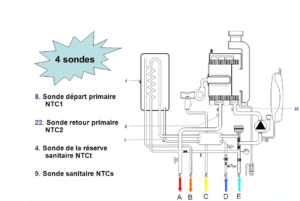 The condensing boiler now includes a complex control system using a plurality of temperature sensors. If we have a look at Chaffoteaux Tania Green boiler, it includes internally 2 sensors per circuit (inbound temperature, outbound temperature), then 4 sensors for 2 circuits.
The condensing boiler now includes a complex control system using a plurality of temperature sensors. If we have a look at Chaffoteaux Tania Green boiler, it includes internally 2 sensors per circuit (inbound temperature, outbound temperature), then 4 sensors for 2 circuits.
The inbound and outbound temperatures are sufficient to regulate thermally a home if the conditions are constant. The temperature difference between those is proportional to the energy delivered in the house. If the temperature difference is low, then the boiler should stop heating. This is a particularly effective way to regulate for high inertia heating systems such as underfloor heating.
Of course conditions are varying, especially the outdoor temperature changes from season to season. The amount of energy to provide inside the house is proportional to the temperature outside. The outdoor temperature sensor adapts the outbound water temperature in regards to outdoor temperature. Now perfect heating temperature regulation is possible if the water rule is optimal.
However there are also other source of energy inside the house that are varying quickly : electrical appliances (oven, hob), solar gain, human presence. The indoor thermostat takes into consideration those variations with a quick reaction time.
To Summarize this, the 3 different kind of regulation types that have to be put in place are :
- stop heating if the temperature of the inbound water is close to the outbound temperature
- establish a water rule using an outdoor temperature sensor, and optimize settings
- use an indoor thermostat to finely regulate the indoor temperature
We’re going to focus on step 2, optimization of water rule.
Optimize water rule
The water rule can only be checked if indoor thermostat is disableb. The easiest way to do this is to set a high setpoint (eg 26 ° C). If the temperature regulation is set correctly, the internal temperature is stabilizing and varying slightly. It’s then correctly regulated in relation to the outdoor temperature.
To perform the test:
- do the test in a season where heating is required and outdoor temperature’s varying widely between day and night (beginning of winter).
- Set the thermostat to a very high temperature to block its action
- Record the indoor and outdoor temperatures throughout the day. (Thanks to my smarthome system and my eedomus controller)
- Analyze data, make configuration adjustment of the boiler settings
- Restart the test another day if the results are not yet optimal
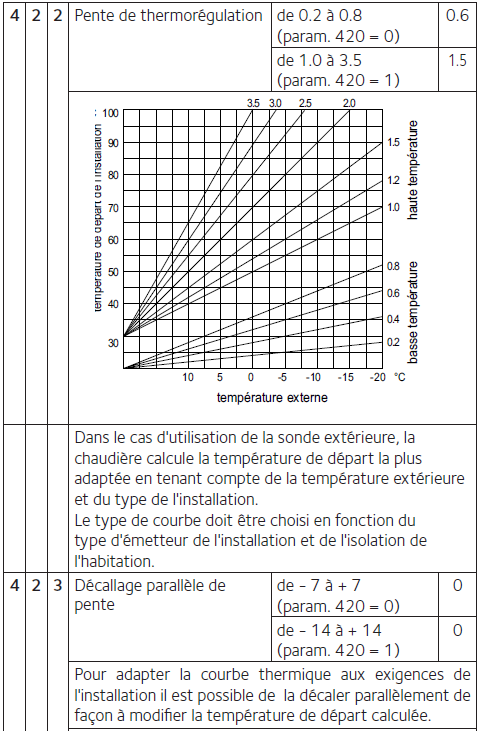 Most of time my indoor temperature setpoint is between 20 ° and 21 °. So I’ve tuned parameters in order to have indoor temperature to stabilize at 22 ° C with indoor thermostat disabled.
Most of time my indoor temperature setpoint is between 20 ° and 21 °. So I’ve tuned parameters in order to have indoor temperature to stabilize at 22 ° C with indoor thermostat disabled.
Two parameters have to be tuned :
- the variation of hot water temperature according to the outdoor temperature.
We have then to tune the slope of control of the outbound water temperature versus outdoor temperature.
In the case of Chaffoteaux Talia Green, it’s parameter number 422 for heating zone 1.
The slope giving the most stable temperature throughout the day has to be selected - the average indoor temperature during the day.
We have to globally increase or decrease the reference temperature of the outbound hot water.
In the case of Chaffoteaux Talia Green, it’s parameter number 423 for heating zone 1.
The setting that provides the desired indoor temperature have to be selected (22 ° C)
Conclusion
It took me 3 days to optimize my heating system parameters, with a quick analysis of data and parameter adjustment each night. I finally changed a single parameter : the slope (parameter 422), which I increased from 1.5 to 2.0.
This change may not have any influence on consumption, but it improved comfort. The default setting set by the fitter was indeed too optimistic and didn’t allow to keep a constant temperature in case of low temperatures. Thanks to correction, we have never ever had this feeling of cold house.
The fitter can’t evaluate the thermal performance of a house when making the initial settings. It therefore applies the standard settings that can’t be optimum for all houses. A home automation system records the temperature history, it provides the tools to change methodically settings for a specific house.

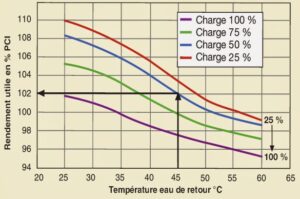
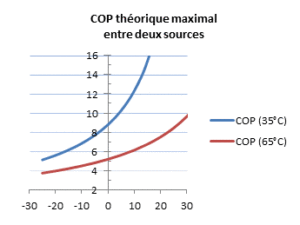
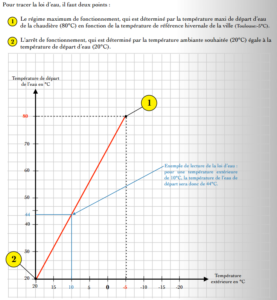
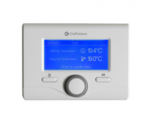

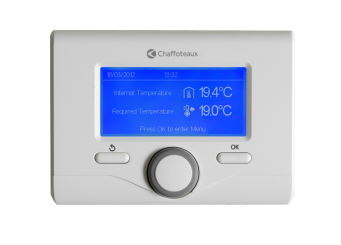
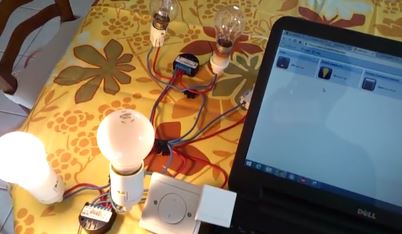
Bonjour
Pour ma part j’ai une pompe à chaleur Panasonic monobloc
J’ai une télécommande pour régler mais il fait toujours trop chaud il y a une fonction Timer mais je ne comprends pas le fonctionnement
Avez vous un tuto pour les Pac
Merci
Je viens de découvrir ce site, et ce tuto très intéressant.
Je pense que bien des personnes possèdent une chaudière qu’ils ne savent pas régler !!!
J’aurais pour ma part des questions à poser mais j’ignore si le thème sur la régulation est encore ouvert.
Merci de laisser 1 commentaire ou de m’adresser une réponse par mail si c’est toujours le cas.
Cordialement,
Raymond
Bonjour,
Je ne comprend pas bien le sens de votre remarque.
Le site web est toujours actif. Avez-vous des questions ?
Bonjour,
Merci pour tes conseils, j’ai cependant une question. Quand tu dis qu’il faut une consigne de 26° pour désactiver le thermostat, tu parles de la température nécessaire pour que la chaudière se mette en route ; ou bien, la température que la chaudière doit atteindre (c’est ma définition de la consigne)?
Merci pour tes pécisions
Bonjour,
Quand je parle de consigne, je veux dire le réglage sur le thermostat. Si on le règle à une température haute, la chaudière ne devrait pas être capable de l’atteindre si la loi d’eau est bien réglée.
Régler la chaudière en fonction de la T° extérieur est à la mode en ce moment l’analyse de la courbe de la chaudière est très utile, j’ai plus de 10 ans d’historique avec 11 sondes DS18B20 câblées en 1-wire allant aussi dans le frigo et le congélateur y compris un sonde sur la T° de sortie chaudière qui me permet de savoir combien de temps elle tourne en analysant le sens de la courbe (bon maintenant je ferais différemment avec une sonde de courant sur le thermostat ou remplacer le thermostat par un modèle connecté). Mais c’est sympa de voir comment régi la maison (de campagne) à chaque mise en chauffe et refroidissement, et le jour où je vais isoler ses gros “mur de 60cm” je verrai la différence même en testant différents isolants pièce par pièce pour voir lequel est le plus efficace.
Intéressant.
Comment sont récupérées et stockées les informations des sondes 1 wire ?
Merci pour ce tuto des réglages de chaudière. Je me posais la question de savoir si tu avais “neutralisé” les apports extérieurs de chaleur pendant tes tests? (Laisser tous les volets fermés par exemple). Merci
Bonjour,
Je n’ai pas pensé à neutraliser les apports extérieurs en gardant les volets fermés. Et pourtant j’aurais pu le faire en désactivant quelques règles eedomus. Bonne remarque.
Par contre j’ai neutralisé les apports humains; rassure toi, ils se portent bien, ils étaient juste absents pendant ces trois jours de test.
Pour ce qui est des appareils ménagers, étant en mode célibataire ils n’ont que peu fonctionné 🙂